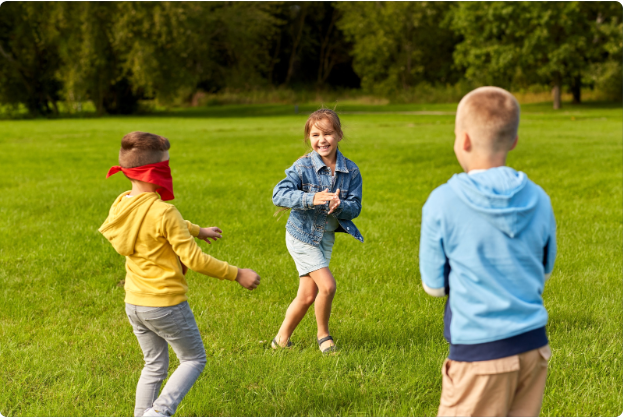Blindfold games for kids are a fantastic way to enhance their sensory perception, spatial awareness, and critical thinking skills, all while having a lot of fun!
These interactive activities provide a unique experience that encourages children to rely on their other senses, such as touch, hearing, and smell, to navigate the world around them.
We will explore exciting blindfold games for kids that guarantee laughter, excitement, and unforgettable moments of joy.
Blindfolded Obstacle Course:
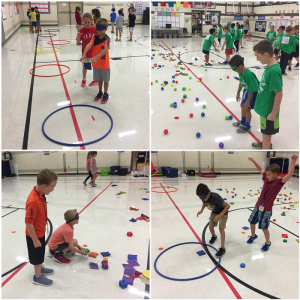
Create a thrilling blindfolded obstacle course in your backyard or a spacious indoor area. Lay out various obstacles such as cones, cushions, hula hoops, and low hurdles. One child wears the blindfold while their partner guides them through the course using only verbal cues. The blindfolded child must trust their partner’s instructions and rely on their heightened senses to successfully navigate the challenges. This game not only fosters teamwork and communication but also boosts the blindfolded child’s self-confidence as they conquer each obstacle with courage.
Pin the Tail on the Donkey:
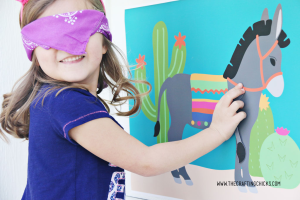
A classic blindfold game that never gets old! Hang a large picture of a donkey on a wall and prepare paper tails with adhesive on one end. Blindfold each child in turn, spin them around gently, and let them attempt to pin the tail on the donkey while being guided by their friends’ directions. This game is perfect for parties and encourages children to use their listening skills and spatial awareness to place the tail as accurately as possible.
Blindfolded Drawing Challenge:
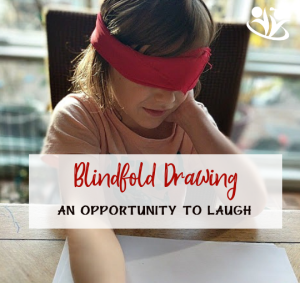
Unleash the budding artists in the group with a blindfolded drawing challenge. Give each child a sheet of paper and a marker or crayon. Blindfold them and present a simple object or shape to draw. It could be a star, a smiley face, or a house. The blindfolded child must use their tactile perception and fine motor skills to create the drawing without seeing it. The results are often hilarious and surprising, leading to giggles and amusement all around.
Related: 20 Fun and Galore Pillow Games for Kids
Blindfolded Taste Test:

Combine sensory exploration with a blindfolded taste test. Prepare an array of different foods or snacks, making sure to include both familiar and less common items. Blindfold each child and have them taste each food one by one, guessing what they are without relying on sight. This activity not only introduces children to new flavors but also encourages them to explore their sense of taste and discuss their impressions and preferences.
Blindfolded Musical Chairs:

Put a twist on the traditional musical chairs game by incorporating blindfolds. Arrange chairs in a circle, with one fewer chair than the number of children participating. As the music plays, the children walk around the chairs. When the music stops, they must quickly find a chair and sit down while blindfolded. The child left standing without a chair is out for the round. Remove one chair and continue until only one child remains. This game combines listening skills, quick decision-making, and a dash of excitement as the chairs disappear one by one.
Blindfolded Feel and Guess:

In this tactile challenge, prepare a collection of various objects with different textures and shapes. Blindfold each child and place one object in their hands at a time. The blindfolded child must feel the object and guess what it is solely based on touch. Include items like a soft plush toy, a rough sponge, a smooth stone, or a squishy stress ball. This game encourages children to explore their sense of touch and helps them develop a deeper appreciation for the diversity of textures in the world around them.
Blindfolded Statues:

In this hilarious and entertaining game, one child is blindfolded and stands in the center while the others position themselves around them in a circle. When the music starts playing, the blindfolded child begins to spin around. As soon as the music stops, the other children freeze into statues. The blindfolded child removes their blindfold and tries to identify the moving “statue” they were facing when the music stopped. This game challenges children’s memory, spatial awareness, and ability to stay motionless.
Related: 20 Exciting Warm Up Games for Kids
Blindfolded Animal Sounds:

Let the kids unleash their inner animal in this sound-based blindfold game. Each child takes turns wearing the blindfold while the others gather in a circle around them. Assign each child an animal sound they must make without revealing their identity. The blindfolded child listens to the animal sounds and tries to guess who is making each sound. This game is not only a blast to play but also enhances children’s listening skills and ability to differentiate between various sounds.
Blindfolded Mystery Box:
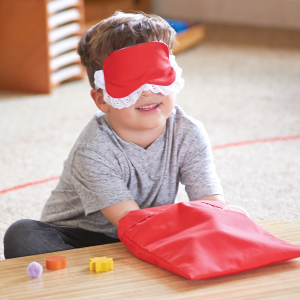
Prepare a mystery box filled with different objects, toys, or even edible treats. Blindfold each child, and one by one, have them reach into the box and touch the item inside. They must use their sense of touch to guess what’s in the box. To make it even more exciting, you can add unexpected items with unusual textures or shapes. This game encourages children to be curious and imaginative, as they explore what might be concealed within the mysterious box.
Blindfolded Memory Tray:
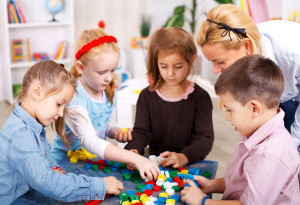
This memory-enhancing game challenges children to test their observation skills. Place a selection of small objects on a tray and allow the children to study them for a brief period. Cover the tray with a cloth and remove one or more items without the children seeing. Uncover the tray and have the children identify the missing objects. The blindfolded aspect adds an extra layer of challenge, as they must rely solely on their memory to recall the items they saw earlier.
Blindfolded Simon Says:

A blindfolded twist on the classic game of Simon Says! One child wears the blindfold while the designated “Simon” gives commands. The blindfolded child must listen carefully and follow the instructions, while the others try to trick them with fake commands. For example, “Simon says touch your nose,” or “Simon says hop on one foot.” This game not only sharpens listening skills but also adds an element of surprise and laughter as the blindfolded child tries to decipher the true commands from the false ones.
Blindfolded Hide and Seek:

Take the excitement of hide and seek up a notch by adding blindfolds. One child is blindfolded and counts while the others hide. Once the counting is done, the blindfolded child searches for their friends using only their hearing and touch to locate hidden players. This game encourages children to rely on their instincts and spatial awareness to find their friends in the most unexpected hiding spots.
Blindfolded Storytelling:
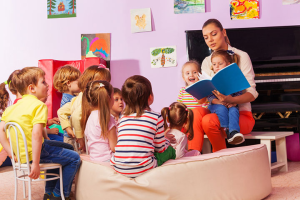
Foster creativity and imagination with blindfolded storytelling. One child is blindfolded and begins telling a story. As the story progresses, each child in the group takes turns adding a sentence or two to continue the narrative. The blindfolded child must use their listening skills to grasp the unfolding story and seamlessly contribute when it’s their turn again. This cooperative storytelling game promotes teamwork and encourages children to build on each other’s ideas.
Blindfolded Guess the Sound:
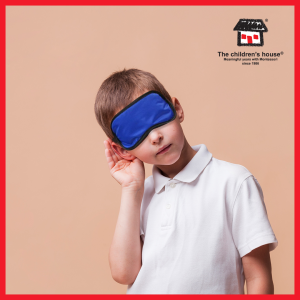
Prepare a variety of sound-making objects or instruments, such as a bell, shaker, whistle, or hand clapper. Blindfold each child and have them take turns making a sound with one of the objects. The other children must guess which object made the sound based on their listening skills. This game enhances auditory discrimination and helps children recognize and differentiate between various sounds.
Blindfolded Guess the Mystery Smell:
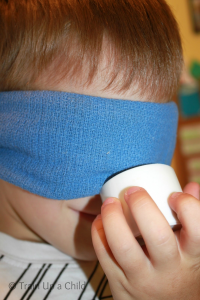
Transform smelling into a guessing game! Gather a range of scented items like spices, fruits, flowers, or scented markers. Blindfold each child and hold each item under their nose one at a time. They must try to guess the mystery scent using only their sense of smell. This game not only enhances olfactory perception but also introduces children to the diverse world of scents.
Blindfolded Feel the Shape:
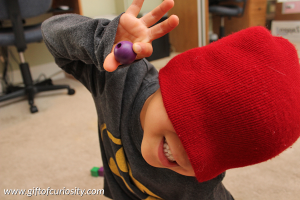
Enhance tactile perception and shape recognition with this blindfolded game. Prepare a collection of geometric shapes made from various materials, such as cardboard, foam, or fabric. Blindfold each child in turn and hand them a shape to feel. They must identify the shape solely through touch and guess whether it’s a circle, square, triangle, or another shape. This activity helps children become more familiar with different shapes and develops their ability to identify them without relying on sight.
Blindfolded Instrument Guessing:

If you have musical instruments available, blindfold each child, and let them take turns playing an instrument while the others listen. The blindfolded child must guess the instrument based solely on the sound it produces. This activity enhances auditory discrimination and introduces children to various musical sounds and instruments.
Blindfolded Memory Game:
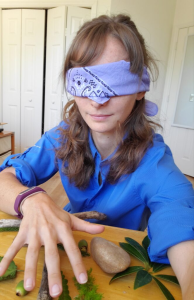
Put a twist on the classic memory game by adding blindfolds. Arrange a grid of cards face down with matching pairs. Blindfold one child and have them try to find matching pairs by flipping over two cards at a time, relying on their memory to remember the locations of the cards. This game sharpens memory skills and concentration while adding an element of mystery and challenge.
Blindfolded Nature Walk:
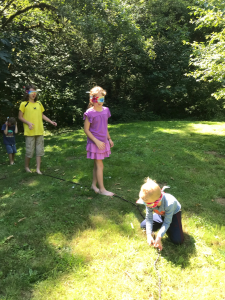
Take the blindfolded fun outdoors with a nature walk! Blindfold one child at a time and let them experience the wonders of nature using their other senses. As they walk, encourage them to feel the textures of leaves and tree bark, listen to the sounds of birds and rustling leaves, and even smell the fragrances of flowers or freshly cut grass. This activity fosters a deeper connection with nature and heightens children’s appreciation for the world around them.
Blindfolded Charades:
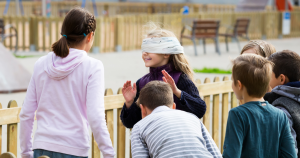
Charades become even more entertaining when played blindfolded! Each child takes turns wearing the blindfold while acting out animals, actions, or objects for the others to guess. The blindfolded child relies on their gestures and verbal cues from their friends to communicate the clues. This game encourages creativity, active listening, and expressive communication.

